SA Standard Service Dagger by Lauterjung (Tiger; RZM marked)
CATEGORY: Version
SKU: 51.GOR.04.03.008.003
Estimated market value:
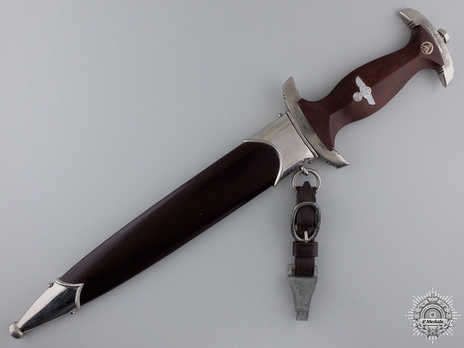

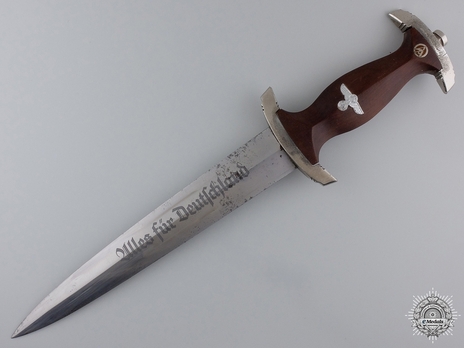
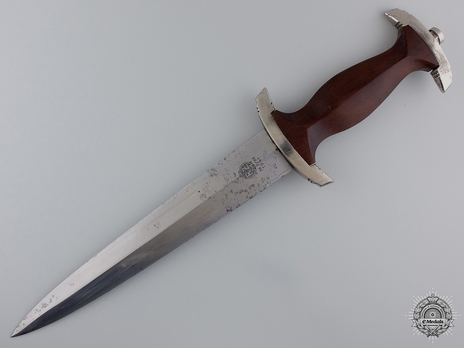
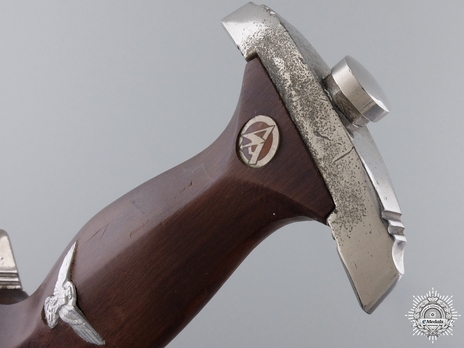
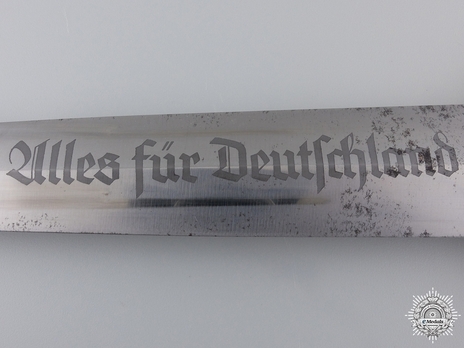
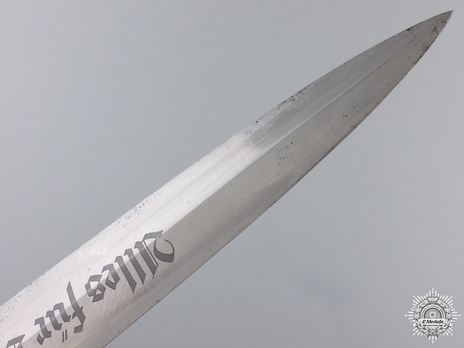
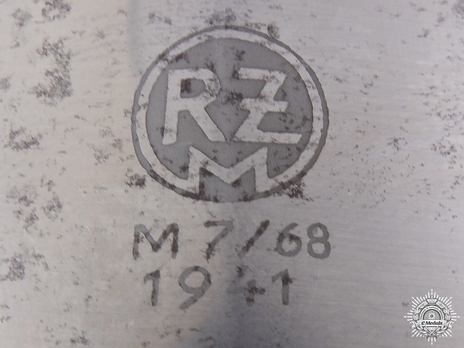
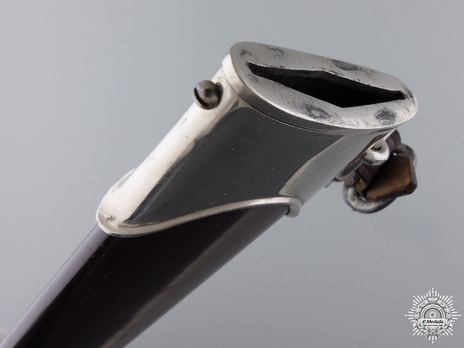
Estimated market value:
An RZM SA Dagger by Tigerwerk Lauterjung & Co., Solingen - Measuring 378 mm in length with the scabbard on, this SA dagger is engraved "Alles für Deutschland" on the blade, magnetic, exhibiting beautiful crossgraining, with the usual in and out runner marks, semi-sharp edges and a very sharp tip. It is marked with the RZM (Reichszeugmeisterei) insignia, maker marked "M7/68" (Tigerwerk Lauterjung & Co., Solingen) and dated "1941" on the reverse ricasso, measuring 222 mm in length, with scattered surface wear and rating better than very fine. Nickel plated fittings on both crossguards exhibiting surface wear, the pommel remaining crisp. Replacement dark wooden handle with a very bright, smooth finish, light contact and without chipping, embedded finely-detailed aluminum eagle is a also a replacement, while the SA insignia exhibits very little contact, the brown enamels and silvering intact, the dagger measuring 345 mm overall. The scabbard fittings exhibit very light contact and surface wear, the brown painted body with a gloss finish, magnetic, exhibiting moderate contact marks and surface wear in the paint from active use. The chape and locket each held firmly in place via two screws each, the ring attached to the locket, an original leather dagger hanger strap attached to the ring with buckle and functioning clip, the strap marked with the RZM insignia and maker marked "L2/338/41" (Leunert, Bruno, Bretnig, SA.), the clip marked with the RZM insignia and maker marked "M5/71" (Overhoff & Cie., Lüdenscheid) with the company's OLC diamond-shaped insignia below, the scabbard measuring 252 mm in length. Near very fine.
The SA (Sturmabteilung, storm detachment) was established in 1921 as a paramilitary protection squad of the NSDAP. The members of the SA were tasked with protecting party leaders at political rallies and meetings from the paramilitary forces of the opposing political factions. The SA was first utilised on November 4, 1921 at a meeting held in Munich’s "Hofbräuhaus" beer hall. The organisation was banned after the failed putsch in 1923 and was reactivated in February 1925.
The SA Standard Service Dagger was introduced in 1933. It was the first edged weapon sidearm that was approved by the NSDAP. The daggers were distributed by authorised retail stores and all ranks were allowed to carry the weapon. This dagger was the most widely produced one in the Third Reich, with over 100 manufacturers and 200 factories involved in its production.
The standardisation and inspection of the daggers did not begin until late 1933, and as a result, numerous design variations involving colour, size, and materials can be encountered when examining early daggers. In October of 1934, the RZM was instituted to regulate items produced for the NSDAP. The RZM made many subtle changes to the dagger design and all items the organisation approved were stamped with an RZM logo.
The dagger blade was manufactured out of nickel-plated steel and features the motto “Alles für Deutschland” (everything for Germany) etched on the obverse. Prior to standardisation, the motto was etched in a variety of patterns. Prior to the establishment of the RZM, the reverse of the dagger was stamped with the manufacturer’s logo. After 1934, the reverse of the blade was stamped with an RZM logo and the manufacturer’s trademark. In 1936, manufacturing trademarks were replaced with RZM-issued manufacturer's codes. Privately-purchased daggers continued to be marked with the maker’s trademark.
Some daggers can be found personalised in one or more of several ways, for example with the owner's name stamped onto the fittings or etched onto the blade.
Early versions of the scabbard were either produced out of a copper-based material or a steel-based sheet metal. In both cases, the scabbard was then finished with brown paint or a reddish-brown oxide (after 1936 oxidised scabbards were no longer produced). It was eventually determined that the copper-based material was too soft and the scabbards were only to be produced out of the steel-based sheet metal. The hilt and scabbard fittings were originally manufactured out of polished nickel-silver, but this was later changed to nickel-plated or chrome-plated zinc die castings.
The dagger grip was produced out wood and stained brown. A variety of different wood, including pear, apple, and walnut were used. The upper section of the grip features an inlaid SA symbol, and from 1933 to 1934, a national eagle emblem with an elongated body and pointed wings was inlaid below. In 1934, a solid nickel or silver-plated eagle emblem with rounded wings replaced the old pattern. As of 1936, many manufacturers began to produced the eagle emblem out of stamped aluminium. At the same time, manufacturer’s began to produce the upper and lower crossguard out of nickel-plated or chrome-plated zinc in order to reduce the cost of production.
The dagger was suspended from the uniform with a brown leather strap that had a nickel-plated clip at one end, and a nickel-plated buckle at the other end. The strap attaches to a carrying ring on the top section of the scabbard.
After a dagger was produced, it was shipped to distribution centres where SA personnel could purchase them. Some daggers feature district markings on the handguard which indicate where the dagger was purchased. Each district was allotted a two to three letter code, such as WF for Westfalen.
For a short time, a variation of the dagger was produced for members of the Marine-SA (navy SA) that featured a black grip and a black anodized scabbard. This variation is extremely rare. Marine-SA members soon started wearing regular service daggers with gilt or copper-plated fittings instead.

Comments
Sign in to comment and reply.


Scroll Top